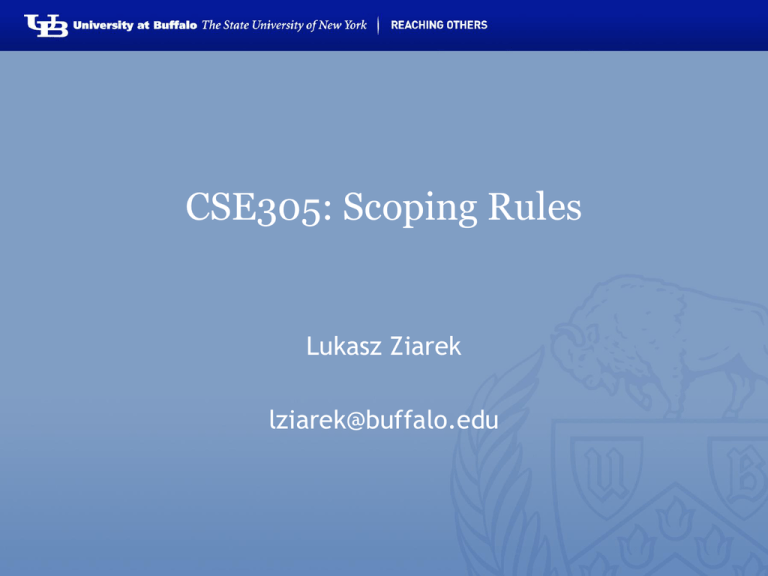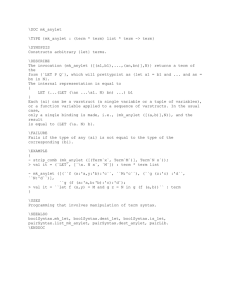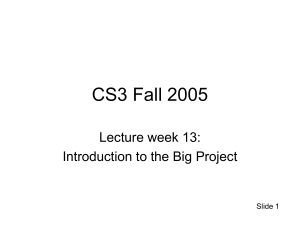CSE3058.pptx
advertisement

CSE305: Scoping Rules
Lukasz Ziarek
lziarek@buffalo.edu
Announcements
• HW2 is now released!
• Please start early, especially the ML portion
• Try to think of an abstract solution, then express
that abstract solution in each language
• Due Monday March 7th 11:59pm
• Start early!
• Ask Questions!
2
“Free” / late days
• Email both the TAs and myself once you turn in your
final submission if you are using “Free” late days
• Confusion about emailing about late days
• Email up to 12 hours AFTER the due date
• Many emailed early and then managed to complete the
assignment
• If you use free late days you must email me and the
TAs when you turn in the assignment
HW2 Language Interpreter
• Implement concepts we discuss in lecture and our
readings
• Slowly build up a language and its interpreter
• Start with arithmetic and a stack
• Parse the input program
• Not as complex as generating a full parse tree
•
Implement the semantic meaning (given
informally via English description) of the
language constructs
4
Variable Attributes: Scope
• The scope of a variable is the range of statements over
which it is visible
• The local variables of a program unit are those that are
declared in that unit
• The nonlocal variables of a program unit are those that
are visible in the unit but not declared there
• Global variables are a special category of nonlocal
variables
• The scope rules of a language determine how references to
names are associated with variables
5
Static Scope
• Based on program text
• To connect a name reference to a variable, you (or the
compiler) must find the declaration
• Search process: search declarations, first locally, then in
increasingly larger enclosing scopes, until one is found for
the given name
• Enclosing static scopes (to a specific scope) are called its
static ancestors; the nearest static ancestor is called a
static parent
• Some languages allow nested subprogram definitions,
which create nested static scopes (e.g., Ada, JavaScript,
Common Lisp, Scheme, Fortran 2003+, F#, and Python)
6
Scope (continued)
• Variables can be hidden from a unit by having a
"closer" variable with the same name
declaration of x
declaration of x
use of x
7
Scope (continued)
• Variables can be hidden from a unit by having a
"closer" variable with the same name
declaration of x
declaration of x
use of x
which x?
use of x
8
Blocks
•
•
A method of creating static scopes inside program units (ALGOL 60)
void sub() {
int count;
while (...) {
int count;
Program constructs (“blocks”)
count++;
create scopes
...
}
…
}
Note: legal in C and C++, but not in Java and C# (too error-prone)
9
The LET Construct
• Most functional languages include some form of let
construct
• A let construct has two parts
•
•
The first part binds names to values
The second part uses the names defined in the first part
• In Scheme:
(LET (
(name1 expression1)
…
(namen expressionn)
)
10
The LET Construct
• In ML:
let
val name1 = expression1
…
val namen = expressionn
in
expression
end;
• In F#:
• First part: let left_side = expression
• (left_side is either a name or a tuple pattern)
• All that follows is the second part
11
Let examples
let val x = "3"
in print (x)
end;
12
Let examples
let val x = "3"
in let val x = "4"
in print(x)
end
end;
13
Let examples
let val x = "3"
val y = let val x = "4"
in print(x)
end
in print(x)
end;
14
Let examples
let val x = "3"
val y = let val x = "4"
in print(x)
end
val _ = print(x)
in print (x)
end;
15
Let examples
let val x = "3"
fun f x = print(x)
in f "4"
end;
16
Let examples
let val x = "3"
fun f y = print(x)
in f "4"
end;
17
Let examples
let val x = "3"
fun f y = print(x)
val x = "4"
in f "4"
end;
18
Let examples
let val x = "3"
fun f y = print(x)
in let val x = "4"
in f "3"
end
end;
19
Let examples
let val x = "4"
val f = let val x = "3"
fun f y = print(x)
in f
end
in f "1"
end;
20
Declaration Order
• C99, C++, Java, and C# allow variable declarations to
appear anywhere a statement can appear
• In C99, C++, and Java, the scope of all local variables is
from the declaration to the end of the block
• In C#, the scope of any variable declared in a block is
the whole block, regardless of the position of the
declaration in the block
• However, a variable still must be declared before it can be
used
21
Declaration Order (continued)
• In C++, Java, and C#, variables can be declared in for
statements
• The scope of such variables is restricted to the for
construct
22
Global Scope
• C, C++, PHP, and Python support a program
structure that consists of a sequence of function
definitions in a file
• These languages allow variable declarations to
appear outside function definitions
23
Global Scope -- PHP
• Programs are embedded in HTML markup documents, in
any number of fragments, some statements and some
function definitions
• The scope of a variable (implicitly) declared in a function
is local to the function
• The scope of a variable implicitly declared outside
functions is from the declaration to the end of the
program, but skips over any intervening functions
• Global variables can be accessed in a function through
the $GLOBALS array or by declaring it global
24
Global Scope -- Python
• A global variable can be referenced in functions, but
can be assigned in a function only if it has been
declared to be global in the function
25
Python Examples
def f():
print(s)
s = “3”
f()
26
Python Examples
def f():
s = ”3”
print(s)
s = “4”
f()
print(s)
27
Python Examples
def f():
print(s)
s = ”3"
print(s)
s = ”4"
f()
print(s)
28
Python Examples
def f():
global s
print(s)
s = ”3"
print(s)
s = ”4"
f()
print(s)
29
Evaluation of Static Scoping
• Works well in many situations
• Problems:
• In most cases, too much access is possible
• As a program evolves, the initial structure is
destroyed and local variables often become global;
subprograms also gravitate toward become global,
rather than nested
• Solution: Encapsulation!
30
Dynamic Scope
• Based on calling sequences of program units, not
their textual layout (temporal versus spatial)
• References to variables are connected to declarations
by searching back through the chain of subprogram
calls that forced execution to this point
31
Scope Example
function big() {
function sub1(){
var x = 7;
sub2();
}
function sub2() {
var y = x;
}
var x = 3;
sub1();
}
big calls sub1
sub1 calls sub2
sub2 uses x
• Static scoping -- Ref to x in sub2 is to big's x
• Dynamic scoping-- Ref to x in sub2 is to sub1's
x
32
Scope Example
• Evaluation of Dynamic Scoping:
• Advantage: convenience
• Disadvantages:
• While a subprogram is executing, its variables are visible
to all subprograms it calls
• Impossible to statically type check
• Poor readability- it is not possible to statically determine
the type of a variable
33
Scope and Lifetime
• Scope and lifetime are sometimes closely related, but
are different concepts
• Consider a static variable in a C or C++ function
34
Referencing Environments
• The referencing environment of a statement is the
collection of all names that are visible in the statement
• In a static-scoped language, it is the local variables plus all
of the visible variables in all of the enclosing scopes
• A subprogram is active if its execution has begun but has
not yet terminated
• In a dynamic-scoped language, the referencing
environment is the local variables plus all visible variables
in all active subprograms
35
Summary
• Case sensitivity and the relationship of names to
special words represent design issues of names
• Variables are characterized by the sextuples: name,
address, value, type, lifetime, scope
• Binding is the association of attributes with program
entities
36


